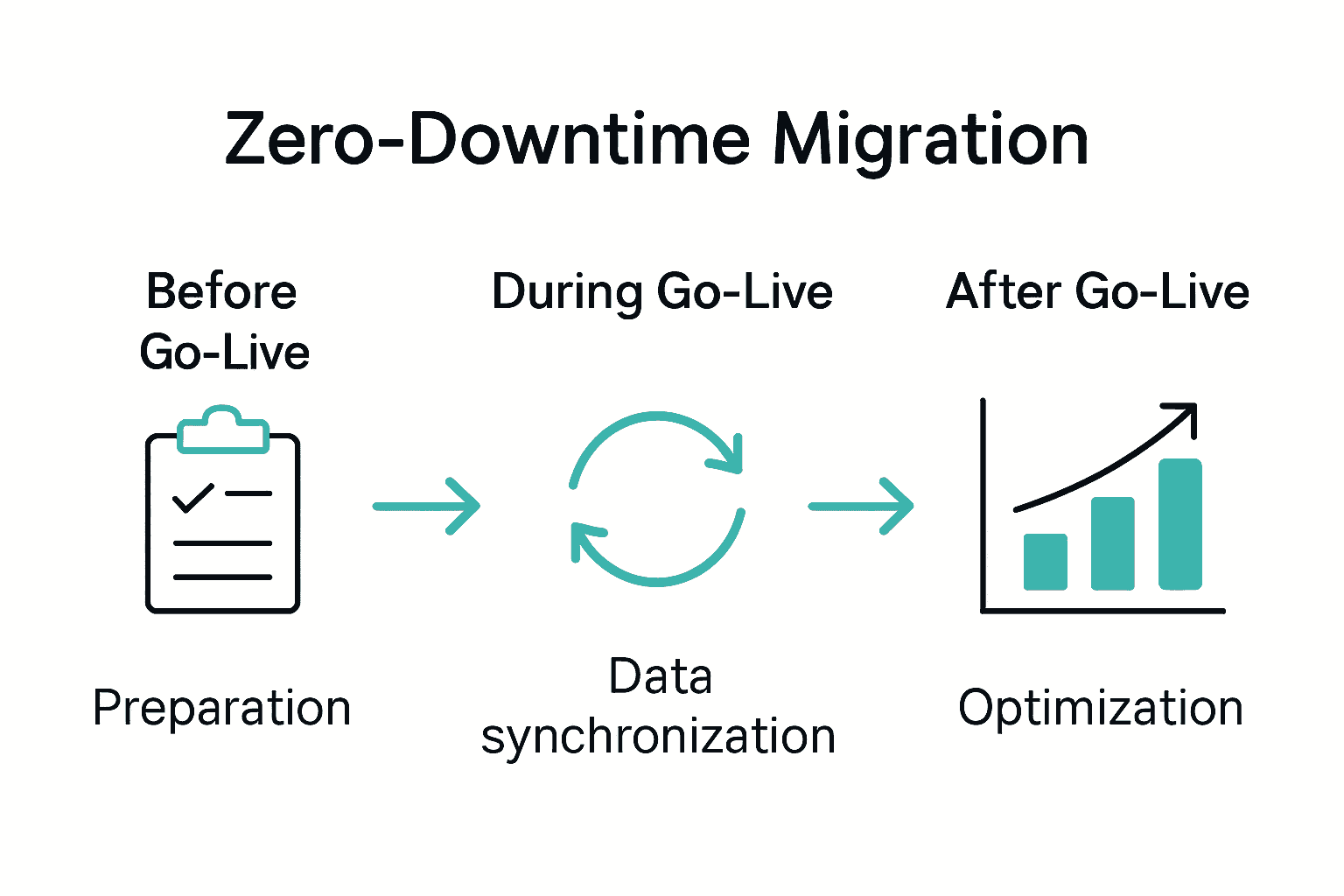19.11.25
Zero-Downtime Migration in Insurance: Complete Guide

Most advice about moving insurance systems overlooks one crucial truth: even a few minutes of downtime can lead to major claims delays and lost business. For insurance companies, continuous service is non-negotiable when modernizing core technology. Zero-downtime migration has become the gold standard for organizations aiming to upgrade without risk. This guide reveals how insurers can achieve seamless system transitions, protect customer trust, and stay ahead in a fast-changing digital world.
Table of Contents
- Zero-Downtime Migration Defined For Insurance
- Modern Migration Approaches And Strategies
- Automation And Reconciliation Standards Explained
- Step-By-Step: Before, During, And After Go-Live
- How Modern Platforms Simplify Migration Complexity
- Minimizing Risk: Migration Without Business Disruption
Key Takeaways
| Point | Details |
|---|---|
| Zero-Downtime Migration | This strategy enables seamless transitions of legacy insurance systems to cloud solutions while ensuring continuous service availability. |
| Modern Migration Approaches | Insurance organizations can choose from lift-and-shift, re-platforming, or re-architecting based on their specific needs and technology landscape. |
| Automation in Migration | Implementing automated processes enhances data accuracy and streamlines workflows, significantly reducing risks associated with manual errors. |
| Comprehensive Planning | Successful migration involves meticulous planning across three phases: pre-migration preparation, active transition, and post-migration optimization to ensure business continuity. |
Zero-Downtime Migration Defined for Insurance
Zero-downtime migration represents a critical strategic approach for insurance organizations seeking to modernize their technology infrastructure without interrupting critical business operations. Zero-downtime migration enables insurers to transition core systems, data, and applications seamlessly while maintaining continuous service availability.
According to research from IJRCAit, this migration strategy provides a comprehensive method for transitioning legacy insurance systems to cloud-based solutions while emphasizing operational continuity. The core objective is eliminating service interruptions that could potentially impact customer experience, claims processing, or revenue generation.
Key characteristics of zero-downtime migration in insurance include:
- Minimal operational disruption
- Continuous system availability
- Synchronized data transfer
- Reduced business risk
- Seamless transition between legacy and modern platforms
A practical example demonstrating this approach comes from Oracle Blogs, where SNIC Insurance successfully transitioned its core systems to cloud infrastructure without experiencing any service interruptions. This case study illustrates how strategic planning and advanced migration techniques can transform technological ecosystems while protecting business continuity.
Understanding zero-downtime migration requires recognizing it as more than a technical process – it’s a strategic business transformation that demands meticulous planning, robust technical architecture, and a holistic approach to change management. Insurers must view this migration not as a one-time event, but as an ongoing journey of technological adaptation and optimization.
Modern Migration Approaches and Strategies
Cloud migration in the insurance sector has evolved dramatically, presenting multiple sophisticated strategies for transitioning legacy systems into modern technological ecosystems. Insurance organizations now have several nuanced approaches to transform their technological infrastructure while minimizing operational disruptions.
According to research from IJRCAit, insurers can leverage three primary migration strategies: lift-and-shift, re-platforming, and re-architecting. Each approach offers unique advantages depending on an organization’s specific technological landscape and strategic objectives.
Migration approaches typically include:
- Lift-and-shift: Moving existing applications to cloud infrastructure with minimal modifications
- Re-platforming: Making targeted optimizations to leverage cloud capabilities without extensive redesign
- Re-architecting: Completely reconstructing applications using cloud-native architectures
Research from IJeret further highlights the potential of microservices and containerization in modernizing legacy insurance systems. These technologies enable more flexible, scalable, and resilient technological architectures that can adapt quickly to changing business requirements.
Successful modern migration strategies demand a holistic approach that balances technological capabilities with business continuity. Insurance organizations must carefully evaluate their current systems, future growth potential, and risk tolerance to select the most appropriate migration methodology. The goal is not just technological transformation, but creating a more responsive, efficient, and competitive insurance technology ecosystem.
Automation and Reconciliation Standards Explained
Automation has become a critical cornerstone in modern insurance system migrations, transforming how organizations manage complex technological transitions. By implementing sophisticated automated processes, insurers can significantly reduce human error, enhance data accuracy, and streamline intricate migration workflows.

According to research from IJRCAit, automation plays a pivotal role in cloud migration by introducing robust validation processes that ensure data integrity and maintain strict compliance with industry standards. These automated mechanisms act as sophisticated digital gatekeepers, meticulously checking and cross-referencing data during every stage of system transition.
Key components of automation in migration include:
- Automated validation checks: Ensuring data consistency and accuracy
- Deployment pipeline management: Streamlining system transitions
- Real-time error detection: Identifying and resolving issues instantly
- Compliance monitoring: Tracking regulatory requirements
- Continuous reconciliation: Maintaining data synchronization
Research from IJeret further emphasizes the importance of automated deployment pipelines and advanced reconciliation mechanisms. These technologies enable insurance organizations to maintain precise data consistency, minimize disruptions, and create a seamless transition between legacy and modern systems.
Effective reconciliation standards go beyond simple data matching. They represent a comprehensive approach to ensuring that every piece of information maintains its integrity, accuracy, and regulatory compliance throughout the migration process. By leveraging advanced automation technologies, insurers can transform what was once a complex, error-prone process into a streamlined, reliable, and efficient technological transformation.
Step-by-Step: Before, During, and After Go-Live
Successful zero-downtime migration in insurance requires a meticulously planned, three-phase approach that transforms technological infrastructure while maintaining uninterrupted business operations. Strategic preparation becomes the foundation for a seamless transition, ensuring minimal disruption to critical insurance services.
According to research from Oracle Blogs, the migration process can be comprehensively structured into distinct stages that address pre-migration assessments, real-time monitoring, and post-migration validation. This approach provides insurers with a systematic method to manage complex technological transitions.
The migration journey encompasses three critical phases:
- Before Go-Live Preparation
- Comprehensive system inventory and assessment
- Detailed migration strategy development
- Risk identification and mitigation planning
- Performance baseline establishment
- Stakeholder communication and training
- During Go-Live Execution
- Real-time system monitoring
- Continuous data synchronization
- Immediate issue detection and resolution
- Parallel system operations
- Minimal service interruption management
- After Go-Live Optimization
- Performance validation
- System stability verification
- Post-migration support
- Continuous improvement processes
- Long-term scalability assessment

Research from IJRCAit further emphasizes the importance of a structured cloud integration approach, highlighting that successful migration goes beyond technical implementation. It requires a holistic strategy that balances technological capabilities with business continuity and strategic objectives.
Ultimately, zero-downtime migration is not just a technical process but a strategic transformation. Insurance organizations must view this journey as an opportunity to not only modernize their technological infrastructure but also to enhance operational efficiency, customer experience, and competitive positioning in an increasingly digital marketplace.
How Modern Platforms Simplify Migration Complexity
Modern insurance platforms represent a transformative approach to technological migration, offering sophisticated solutions that dramatically reduce the complexity and risk associated with system transitions. By leveraging advanced architectural design and innovative technologies, these platforms enable insurers to navigate complex migration challenges with unprecedented ease and efficiency.
Research from IJeret highlights how modern cloud platforms, such as the Guidewire Cloud Platform, simplify migration through microservices architecture. This approach fundamentally transforms system design by breaking complex monolithic structures into modular, independently deployable services that can be updated, scaled, and managed with exceptional flexibility.
Key characteristics that simplify migration complexity include:
- Modular architecture: Easy component replacement and upgrades
- API-first design: Seamless system integrations
- Containerization: Improved deployment consistency
- Automated reconciliation: Reduced manual intervention
- Scalable infrastructure: Adaptable to changing business needs
According to research from IJRCAit, cloud-based policy administration solutions are revolutionizing migration processes by significantly reducing operational costs and improving processing efficiency. These platforms provide insurers with tools that transform what was once a complex, risky endeavor into a streamlined, manageable strategic initiative.
Ultimately, modern platforms do more than simply migrate systems. They offer a comprehensive ecosystem that enables insurance organizations to reimagine their technological capabilities, driving innovation, improving operational resilience, and creating more responsive, customer-centric insurance experiences.
Minimizing Risk: Migration Without Business Disruption
Migrating complex insurance systems requires a strategic approach that prioritizes business continuity and minimizes operational risks. Successful migration is not about avoiding change, but about executing technological transformation with precision, foresight, and minimal disruption to critical business processes.
According to research from Oracle Blogs, real-world examples like SNIC Insurance demonstrate how organizations can achieve zero-downtime migration by implementing robust infrastructure strategies that ensure uninterrupted service delivery. Their successful transition to Oracle Cloud Infrastructure illustrates that comprehensive risk management is possible with the right approach.
Key strategies for minimizing migration risks include:
- Parallel system operations: Running old and new systems simultaneously
- Incremental migration: Phased transition of system components
- Comprehensive testing: Rigorous validation at each migration stage
- Continuous monitoring: Real-time performance and stability tracking
- Rollback capabilities: Immediate reversion options if issues emerge
Research from IJRCAit emphasizes the critical importance of thorough pre-migration analysis and robust security practices. By implementing comprehensive risk mitigation techniques, insurers can transform potential technological disruptions into strategic opportunities for operational enhancement.
Risk minimization during migration is fundamentally about maintaining a delicate balance between technological innovation and operational stability. Insurance organizations must approach system transitions not as isolated technical projects, but as holistic business transformations that require meticulous planning, advanced technological capabilities, and a deep understanding of organizational dynamics.
Achieve Zero-Downtime Migration with Confidence Using IBA[NULL]
The challenge of maintaining uninterrupted insurance operations while modernizing legacy systems is at the heart of zero-downtime migration. If you are looking to minimize risk, ensure continuous data synchronization, and adopt automated reconciliation processes during your cloud migration journey, you are addressing critical pain points covered in this guide. Understanding the importance of seamless transitions, operational continuity, and agile technology platforms is essential to reduce disruption and protect your customer experience.
IBA’s cloud-native core insurance platform, IBSuite, is designed exactly for insurers who want to transform without downtime. With its API-first architecture, modular microservices, and built-in automation capabilities, IBSuite supports the full insurance value chain while enabling rapid product innovation and simplifying complex system migrations. Discover how our platform can help you embrace change effortlessly and secure business continuity.
Ready to minimize migration risk and modernize your infrastructure with confidence The best way to see how IBSuite can power your zero-downtime migration strategy is to book a personalized demo today. Don’t wait to transform your core systems and accelerate your digital insurance journey. Visit Insurance Business Applications now and take the first step toward seamless modernization.
Frequently Asked Questions
What is zero-downtime migration in insurance?
Zero-downtime migration allows insurance organizations to modernize their technology infrastructure without interrupting critical business operations, ensuring continuous service availability during the transition process.
What are the key benefits of zero-downtime migration for insurers?
Key benefits include minimal operational disruption, continuous system availability, synchronized data transfer, reduced business risk, and a seamless transition from legacy to modern platforms.
What are the main phases of a successful zero-downtime migration?
A successful zero-downtime migration typically includes three phases: 1) Before Go-Live Preparation, which involves comprehensive assessments and strategy development; 2) During Go-Live Execution, focusing on real-time monitoring and data synchronization; and 3) After Go-Live Optimization, which includes performance validation and continuous improvement.
How does automation enhance the migration process in insurance?
Automation enhances the migration process by introducing automated validation checks, real-time error detection, deployment management, compliance monitoring, and continuous reconciliation, which together streamline the transition and ensure data integrity.
Recommended
- Drivers of Digital Transformation in the Insurance Industry – Digital Insurance Platform | IBSuite Insurance Software | Modern Insurance System
- How to Digitize Insurance Processes for P&C Insurers – Digital Insurance Platform | IBSuite Insurance Software | Modern Insurance System
- 7 Policy Administration Best Practices for Insurers – Digital Insurance Platform | IBSuite Insurance Software | Modern Insurance System
- Why Modernizing Insurance Systems is Crucial for Growth – Digital Insurance Platform | IBSuite Insurance Software | Modern Insurance System